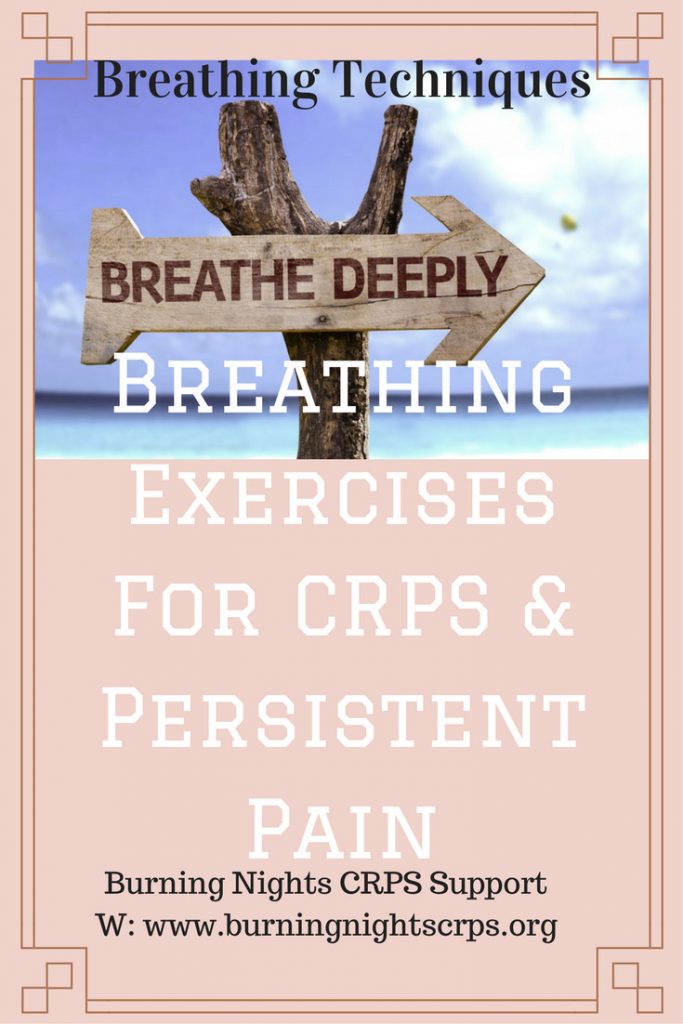We use cookies to improve your experience. By accepting you agree to our cookie policy

There are many alternative therapies, natural remedies and self management techniques that can help with chronic or persistent pain and conditions such as CRPS, CFS/ME, Fibromyalgia and Arthritis. Here we will explore Deep Breathing Exercises as a form of self pain management and how to use them to help cope with CRPS or chronic pain. Although breathing exercises will not cure your chronic pain or CRPS, they could help get you through the day or help you manage a flare up of your pain or symptoms. Breathing exercises are a good self management tool to have and to know.

Breathing exercises, such as those outlined below, not only relax your mind, lessen stress and tension, but will also make you and your brain focus on something totally separate from your pain or flare up.
When you are in a state of frustration, stress, tension or pain your mind and body are not in a sense of relaxation. When you start to slow right down and begin to draw in some deep breaths, the brain and mind begin to slow down and to relax. This then sends a message from the brain to the rest of your body and soon after both the body and mind will become relaxed, your blood pressure will drop, your heart stops racing, and your heavy fast breathing begins to calm down.
It has been found that breathing out engages our ventral vagal system, a part of our parasympathetic nervous system which slows our heart rate and relaxes us. Deep breathing stimulates your blood flow and can help bring more oxygen to your joints and muscles, which can help you with your pain.
Breathing is linked to the autonomic nervous system and practicing breathing every day activates the parasympathetic nervous system. Deep breathing techniques, where you are breathing from your diaphragm rather than shallow breathing from your chest, and meditation that focuses on the breath and eases pain are the best to try. Quick, short shallow breaths from the chest will mean your body is receiving less oxygen, whereas breathing from your diaphragm means your body is receiving more oxygen and you will begin to feel more relaxed. According to the London Pain Clinic they say that diaphragmatic or deep breathing "... also improves circulation and facilitates the most efficient exchange of oxygen and carbon dioxide with the minimum amount of effort."
These types of techniques ease tension in the muscles and allow more even blood flow through to the extremities. The soothing power of the breath or heart beat can let you ignore thoughts of pain. (RSD Attorney)
In a research article by Busch, V et al (2012), where they studied the Deep and Slow Breathing techniques in relation to chronic pain perception, they found that: "… the way of breathing decisively influences autonomic and pain processing, thereby identifying DSB in concert with relaxation as the essential feature in the modulation of sympathetic arousal and pain perception."
The exercises outlined on this page can be varied at any time to suit you, where you are or what you're doing. If you feel dizzy or light-headed when doing the breathing exercises, return your breathing to it's normal rhythm. You can add some gentle music, light some softly scented candles, or put out some fresh flowers or aromatherapy oils in an oil burner to help you to relax. These sounds and smells can improve your breathing, reduce the stress and tension, and hopefully help your chronic pain or flare up.
Bookspan, J. in her article 'Do breathing exercises work?' says: "Don't "overbreathe" (hyperventilate) by taking huge breaths in and out while at rest. That changes your body chemistry, which can make you dizzy or cause temporary limb tingling."
There are many exercises that can be used, but whichever you decide, remember that learning deep breathing exercises will take a little practice and getting used to as it may feel unnatural, but stay with it to try and remove your attention away from your pain.

Deep Breathing can be of great benefit for a good many areas of your life, including:
It is thought that practicing this deep breathing technique for only 10 minutes per day can be helpful in reducing your blood pressure and heart rate.
To help you focus on your breathing, count from 1 to 10 or back from 10 to 1 as you breathe in and out, e.g. 1 – in, 2 – out, 3 – in, 4 – out or the other way round 10 – in, 9 – out, 8 – in…
In this self management article, you will have hopefully learned how to use deep breathing exercises to help you cope with your CRPS or persistent pain. There are many more exercises and techniques for CRPS and persistent pain available, but always remember to contact your pain management team, GP or pain specialist before trying anything new or different to your current medical regime for your specific condition.
Take a look at our other blogs, including our Quick Guide To Pacing For CRPS and Chronic Pain and 11 Coping Strategies For Your CRPS.
*Burning Nights CRPS Support is a registered charity. We are not doctors or specialists and therefore cannot make any diagnosis, provide treatment, etc. You must speak to your doctor or healthcare professional about starting to do any exercises including breathing techniques. This help is not meant to replace your current treatment regime or medication. If in doubt please contact your doctor or pain specialist first.*
Last Updated: 09/03/2024